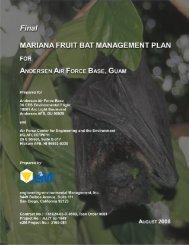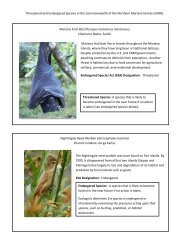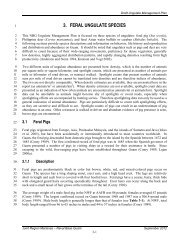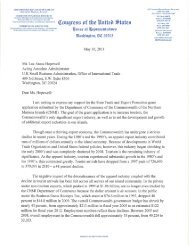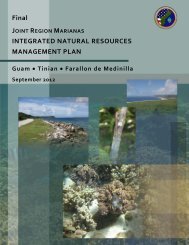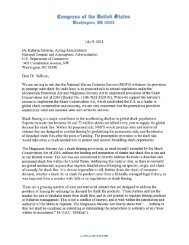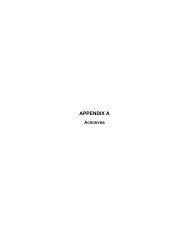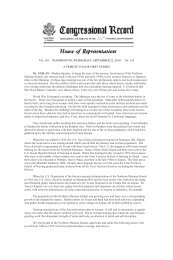4. FERAL UNGULATE SPECIES IMPACTS ON NAVY LANDS
4. FERAL UNGULATE SPECIES IMPACTS ON NAVY LANDS
4. FERAL UNGULATE SPECIES IMPACTS ON NAVY LANDS
You also want an ePaper? Increase the reach of your titles
YUMPU automatically turns print PDFs into web optimized ePapers that Google loves.
1<br />
2<br />
3<br />
4<br />
5<br />
6<br />
7<br />
8<br />
9<br />
10<br />
11<br />
12<br />
13<br />
14<br />
15<br />
16<br />
17<br />
18<br />
19<br />
20<br />
21<br />
22<br />
23<br />
24<br />
25<br />
<strong>4.</strong>2 Impacts on Marine Habitats<br />
Figure 4-<strong>4.</strong> Carabao Inside the Bunker Fence at NBG NMS<br />
Draft Ungulate Management Plan<br />
Guam’s marine habitats, including its unique coral reef ecosystems, deep water, and mangroves, represent<br />
a significant asset to the island’s economy and culture. Guam's reefs are a valuable source of food for<br />
local people, are an important component of Guam's tourism industry, and provide protection from<br />
flooding and storm surge, among other services. Van Beukering et al. (2007) estimated the total<br />
economic value of the services provided by Guam’s coral reefs to be more than $127 million per year.<br />
Sedimentation is one of the primary threats to Guam's coral reefs. Sedimentation of the marine<br />
environment on Guam can be extreme following heavy rain events (Figure 4-5). Talafofo Bay is at the<br />
downstream end of the Fena Watershed, so erosion on the NBG NMS can directly affect the Bay and off<br />
shore habitats. Any land activity that alters or removes vegetation cover, loosens soil, or promotes faster<br />
overland movement of water can increase erosion rates and associated sedimentation on Guam's reefs<br />
(Minton 2005). Ungulates such as pigs uproot vegetation and create hard-packed trails that promote<br />
increased water flow and likely increased erosion. Ungulates contribute to shifts in vegetation<br />
community through consumption of tree seedlings. Changes in vegetation structure can significantly<br />
increase erosion rates. For example, erosion rates in Guam's grasslands have been shown to be more than<br />
60 times higher than in Guam's forests (NRCS 2001).<br />
Sediment in runoff can smother coral on Guam’s fringing reefs (Richmond 1993). Sediment that remains<br />
within the water column (suspended sediment), can reduce light penetration (Rogers 1990), reduce<br />
growth (Rogers 1990), and result in direct mortality of coral larval (Richmond 1997). Depending on<br />
oceanographic conditions, suspended sediments can settle on the bottom and bury coral and other<br />
substratum, potentially resulting in recruitment failure (Hodgson 1990, Gilmour 1999, Minton and<br />
Lundgren 2006, Minton et al. 2007). Sediment from runoff can also block gills; filter feeder apparatus;<br />
and smother sedentary aquatic plants, animals, and their eggs.<br />
Joint Region Marianas – Naval Base Guam September 2012<br />
4-4



